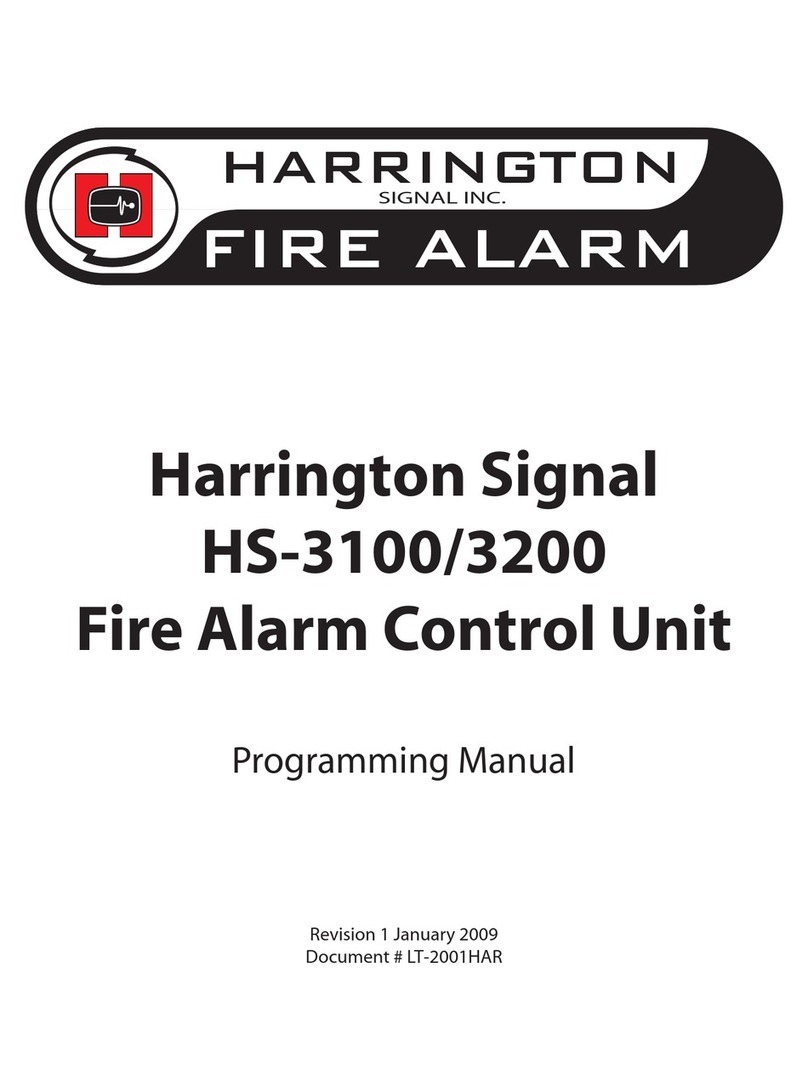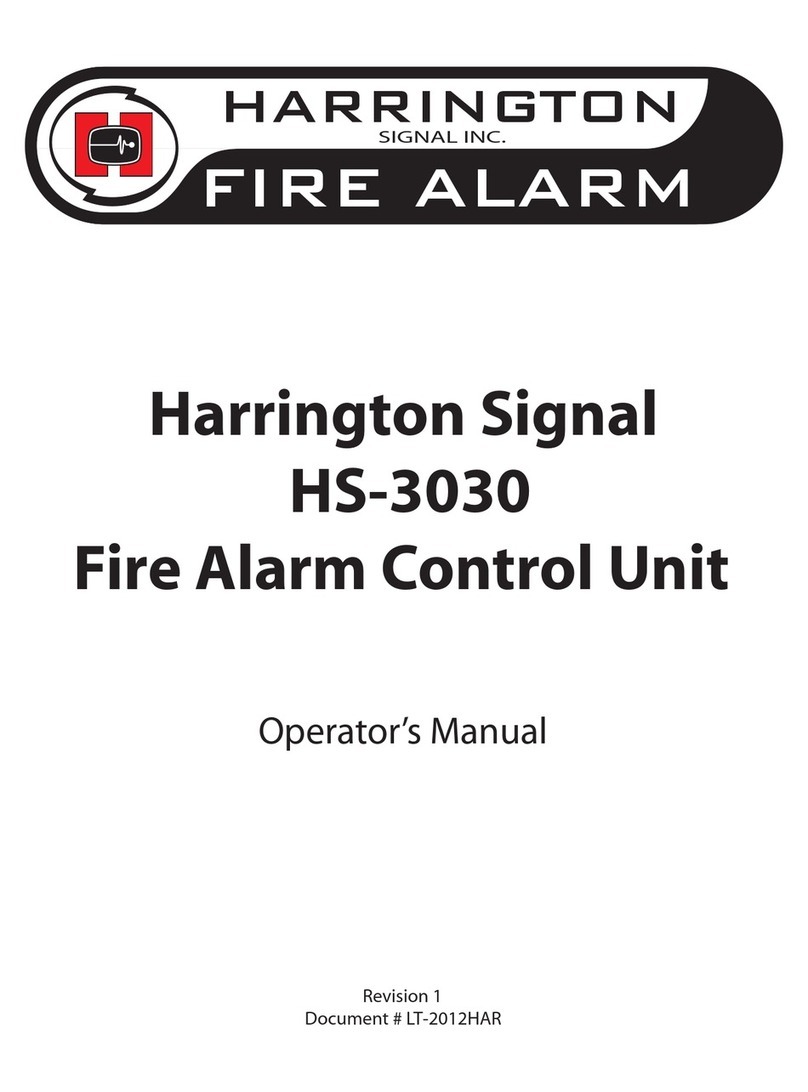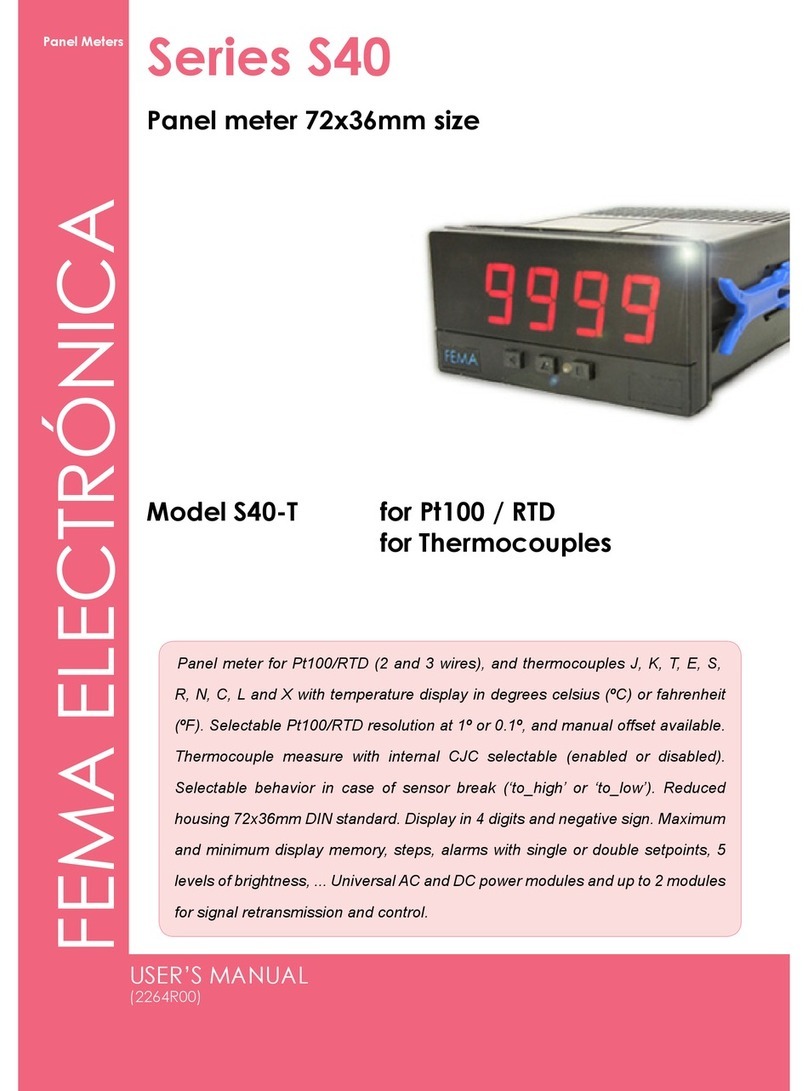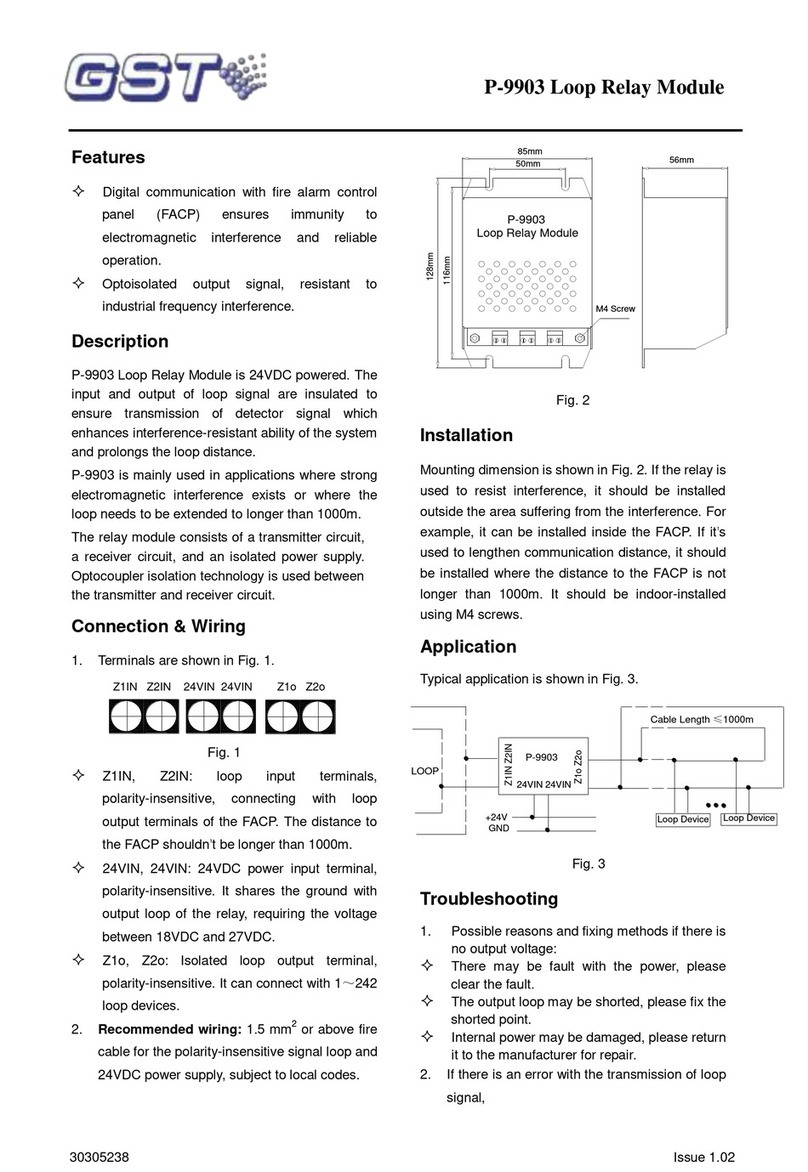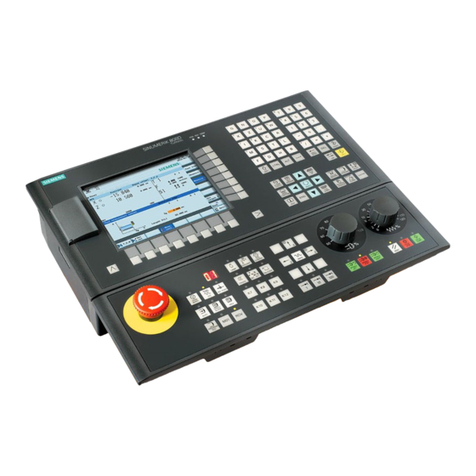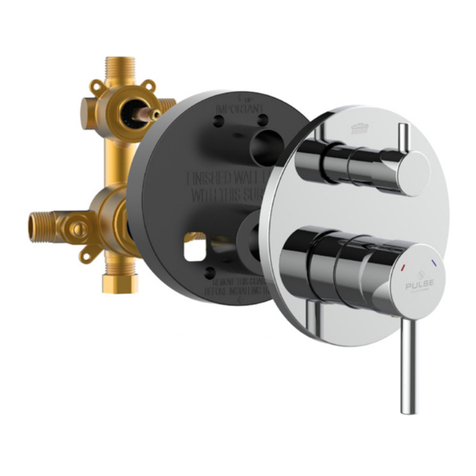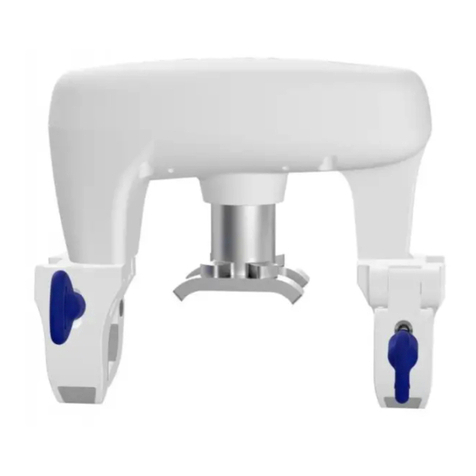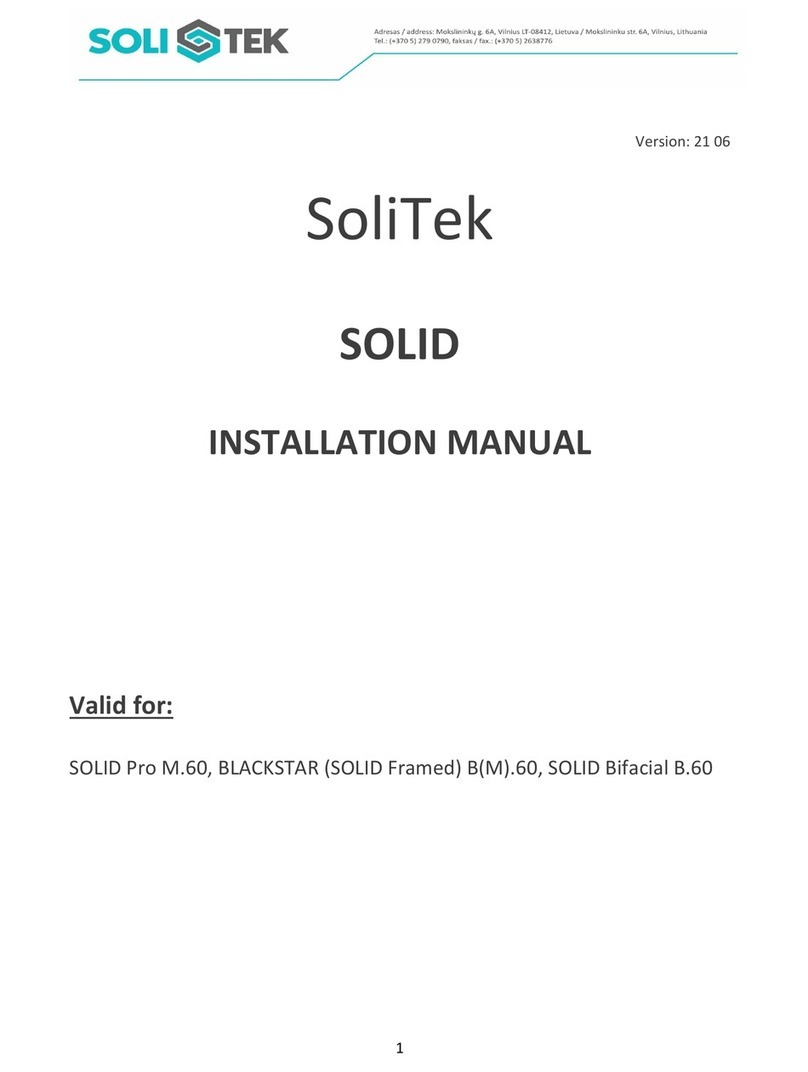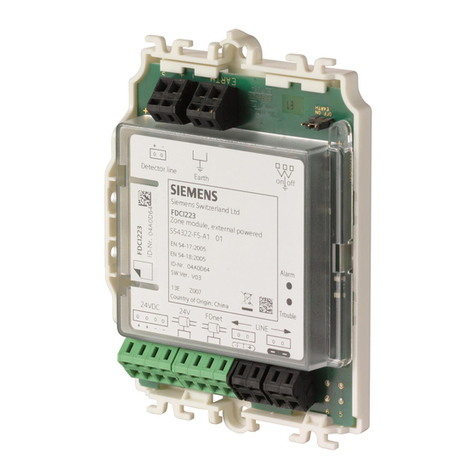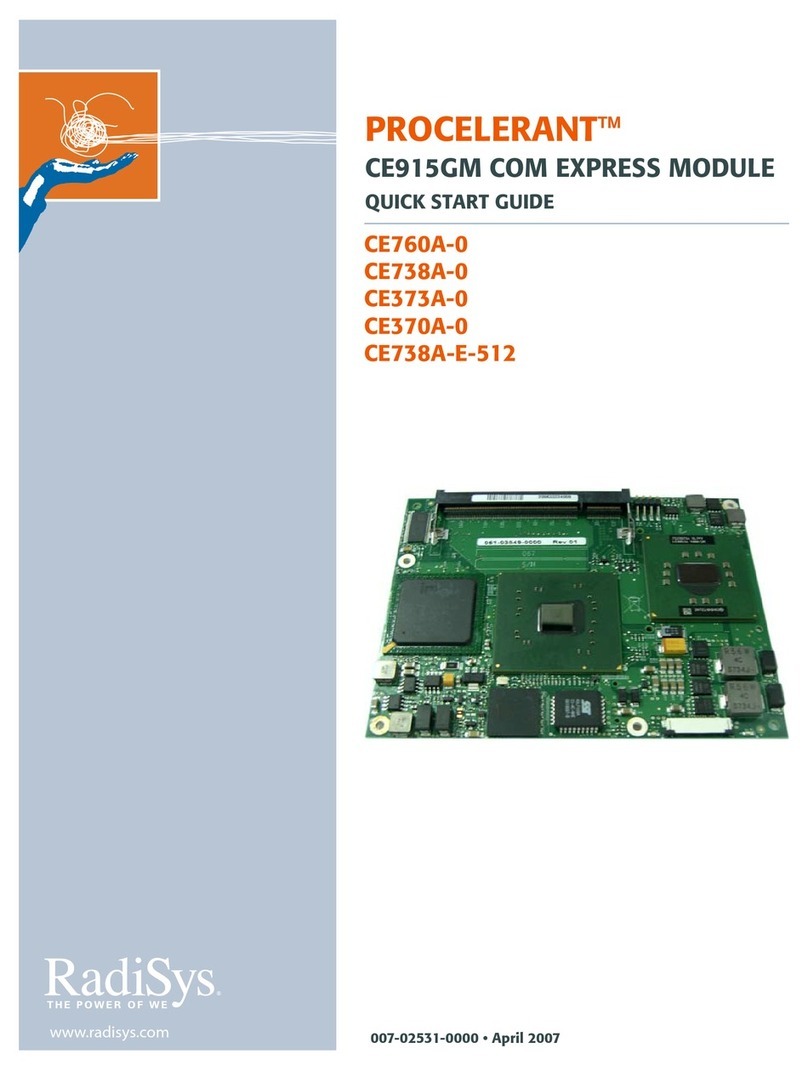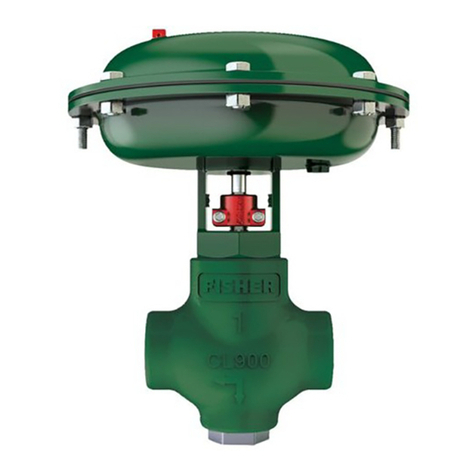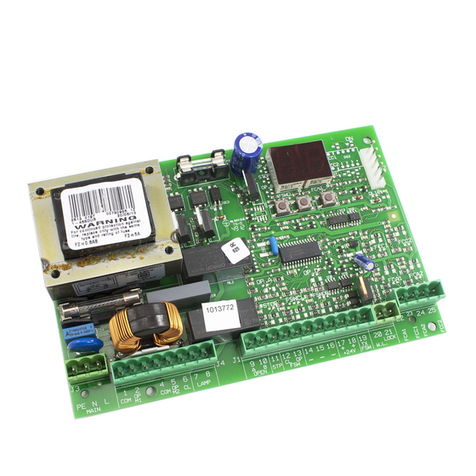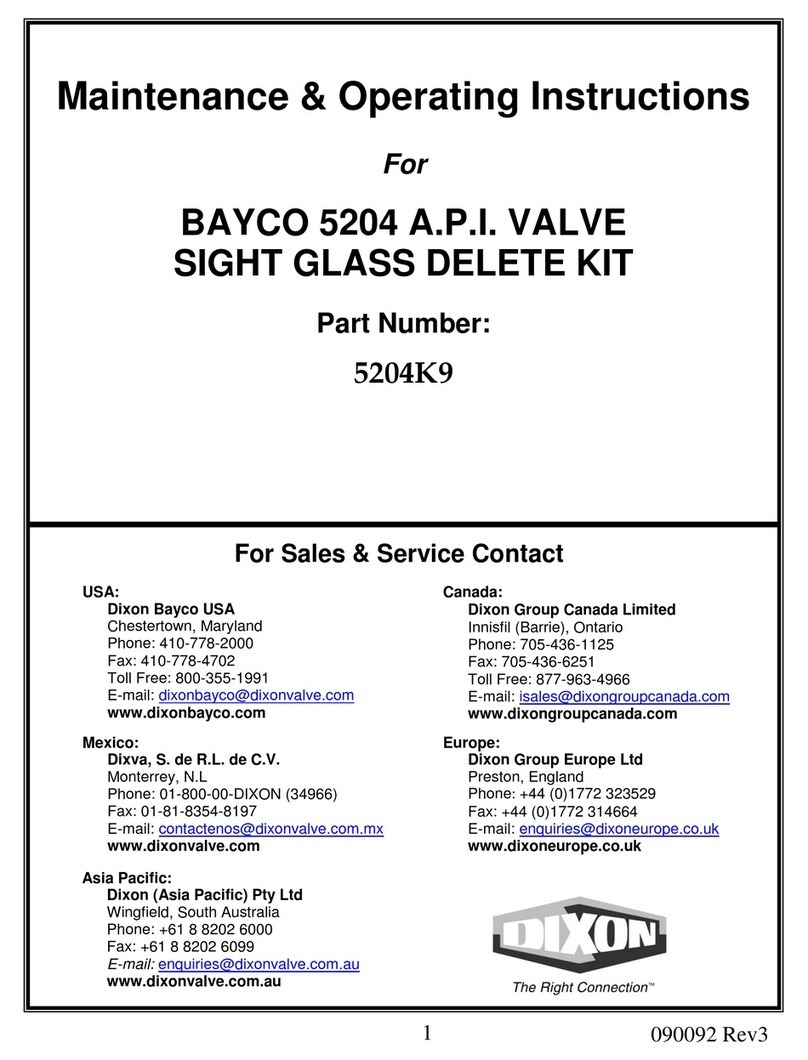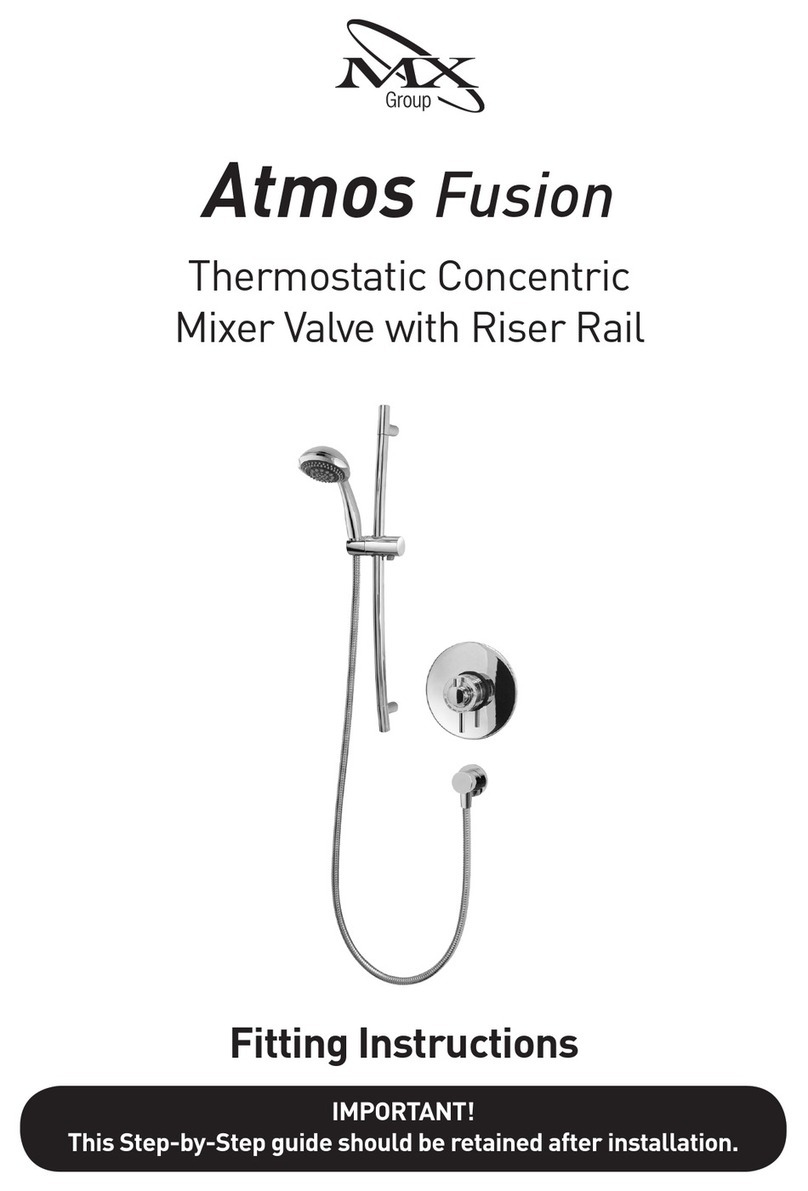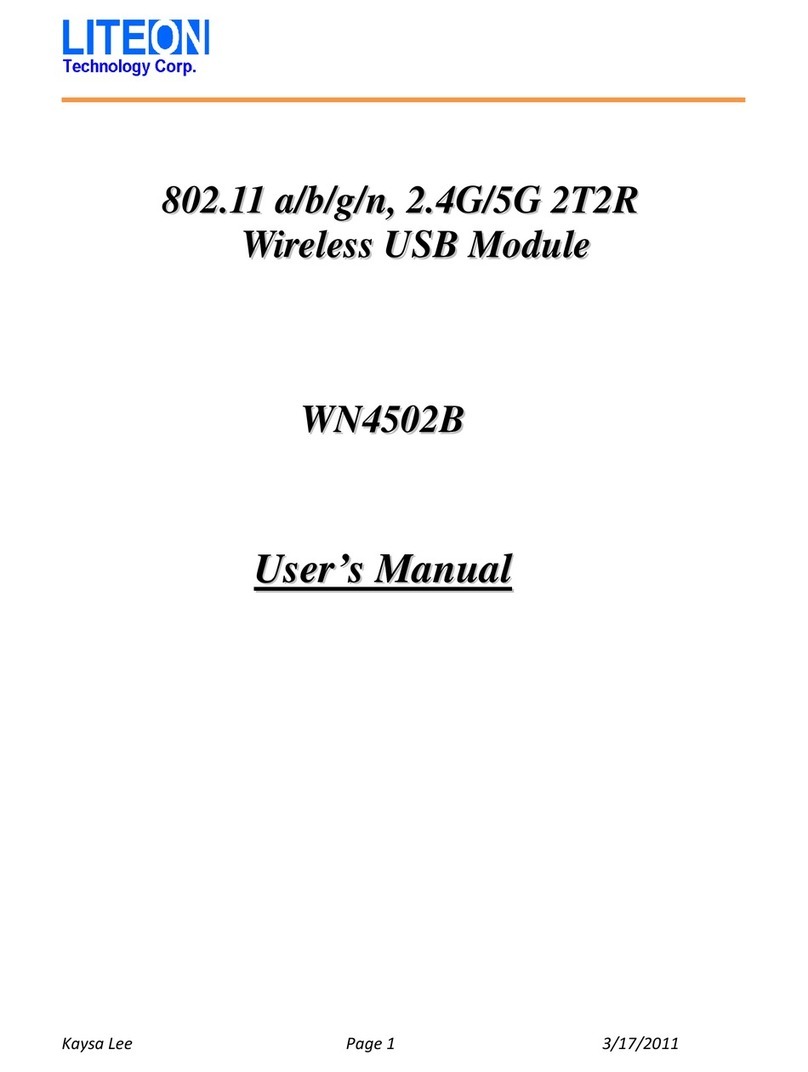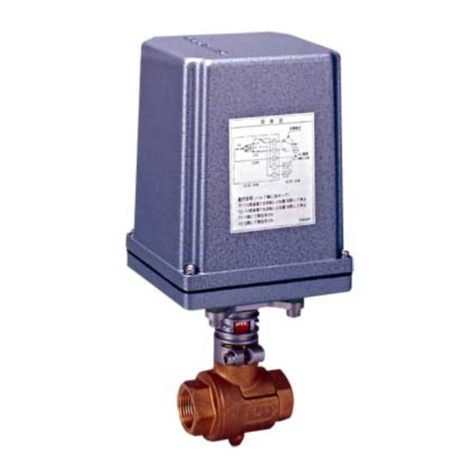Harrington Signal Network Plus HS-3030 User manual

Network Plus™ HS-3030
Fire Alarm Control Unit
Installation Manual
Revision 1
Document # LT-2010HAR
HARRINGTON
FIRE ALARM
SIGNAL INC.


HS-3030 Installation Manual
i
Table of Contents
1.0 Technical Information ......................................................................................................1
1.1 General ......................................................................................................................... 1
1.2 Main Circuit Board .........................................................................................................1
1.3 Front Panel .................................................................................................................... 3
1.4 Input Circuits ................................................................................................................. 3
1.5 Input Circuit Modules .................................................................................................... 4
1.6 Terminal Board .............................................................................................................. 5
1.7 Annunciator Strip ........................................................................................................... 5
1.8 Power Supply ................................................................................................................ 5
1.9 Enclosure ...................................................................................................................... 6
1.10 Networking .................................................................................................................. 6
1.11 Optional Integrated Printer .......................................................................................... 7
2.0 Installation ..................................................................................................................... 8
2.1 Unpacking the HS-3030 ................................................................................................ 8
2.2 Mounting and Assembling the HS-3030 ........................................................................ 9
2.3 Internal Assembly ..........................................................................................................10
2.4 Wiring ............................................................................................................................ 12
3.0 Technical Specifications ................................................................................................. 22
4.0 Parts List ........................................................................................................................... 24
5.0 Appendix A: Power Supply and Battery Calculations .................................................. 26
5.1 General ......................................................................................................................... 27
6.0 Appendix B: ULC Listed Compatible Smoke Detectors ............................................... 28
7.0 Appendix C: UL Listed Compatible Devices .................................................................. 31
7.1 UL Listed “Class B” Smoke Detectors ........................................................................... 31
7.2 UL Listed “Class A” Smoke Detectors .......................................................................... 34
7.3 UL Listed Notification Appliances .................................................................................. 35
7.5 UL Listed Analog Addressable Devices ........................................................................ 42
8.0 Appendix D: Interconnection to Other Equipment ........................................................ 43
8.1 Radionics 2071C and 2071AC ...................................................................................... 43
8.2 Silent Knight 5104 .........................................................................................................44
8.3 CTM City Tie Module .................................................................................................... 45
8.4 Keltron 3158 TTM ......................................................................................................... 46
9.0 Warranty Procedure .........................................................................................................47
9.1 FCC Compliance Statement ............................................................................................ 48


HS-3030 Installation Manual
iii
List of Figures & Tables
Figure 1: Basic Network Communication Flow ................................................................... 6
Figure 2: HS-3030 Exploded View ...................................................................................... 8
Figure 3: HS-3030 and HS-3434 in a Network .................................................................... 10
Figure 4: Back Box Dimension and Knockout Reference ................................................... 11
Figure 5: 120VAC Power Connection ................................................................................. 12
Figure 6: 240VAC Power Connection ................................................................................. 12
Figure 4: Conventional Style B (Class B) Wiring ................................................................. 12
Figure 7: Conventional Style B (Class B) Wiring ................................................................. 12
Figure 4: Conventional Style B (Class B) Wiring ................................................................. 13
Figure 8: Conventional Style A (Class A) Wiring ................................................................. 13
Figure 9: Smoke Detector Circuit Wiring, Style B (Class B) Wiring .................................... 13
Figure 10: Smoke Detector Circuit Wiring, Style D (Class A) Wiring .................................. 13
Figure 11: Normally Closed Wiring ..................................................................................... 14
Figure 12: Normally Open Wiring ........................................................................................ 14
Figure 13: Addressable Style 4(Class B) Wiring ................................................................. 14
Figure 14: Addressable Style 6 (Class A) Wiring ................................................................ 15
Figure 15: M500M Wiring .................................................................................................... 16
Figure 16: M501 Wiring ....................................................................................................... 16
Figure 17: M502M Wiring .................................................................................................... 17
Figure 18: M500S Wiring for Signalling Circuits................................................................... 17
Figure 19: M500R Wiring for Form C Relay Use ................................................................ 18
Figure 20: M500X Wiring .................................................................................................... 18
Figure 21: Style Y (Class B) Bell Circuit Wiring .................................................................. 18
Figure 22: Style Z (Class A) Bell Circuit Wiring ................................................................... 19
Figure 23: Relay .................................................................................................................. 19
Figure 24: Auxiliary Power Connections ............................................................................. 19
Figure 25: Ribbon Cable Installation ................................................................................... 20
Figure 26: Standard Network Wiring ................................................................................... 20
Figure 27: RS-232 Network Wiring ..................................................................................... 21
Figure 28: HS-2802, HS-3644, HS-3801 and HS-3806 Wiring ........................................... 21
Figure 29: HS-3030 and Radionics 2071C/2071AC Wiring ................................................ 43
Figure 30: HS-3030 and Radionics 2071C/2071AC Wiring with addressable module
substituted for alarm relay ................................................................................. 43
Figure 31: HS-3030 and Silent Knight 5104 Dialer Wiring .................................................. 44
Figure 32: HS-3030 and Silent Knight 5104 Dialer Wiring with addressable module
substituted for common alarm relay ................................................................... 44
Figure 33: HS-3030 and Silent Knight 5104 Dialer Wiring with addressable module
substituted for common supervisory relay ......................................................... 44
Figure 34: CTM City Tie Module Wiring .............................................................................. 45
Figure 35: HS-3030 and Keltron 3158 TTM Wiring ............................................................. 46
Table 1: Input Circuit Module Compatibility ......................................................................... 4
Table 2: Maximum Wire Lengths for Conventional Input Circuits ....................................... 14
Table 3: Maximum Wiring Length for Addressable Circuits ................................................ 15
Table 4: Maximum Wire Lengths for Bell Circuits ............................................................... 19
Table 5: Maximum Capacitance for Network Baud Rates .................................................. 20


HS-3030 Installation Manual
1
1.0 Technical Information
1.1 General
The HS-3030 Fire Alarm Control Unit provides capability for up to 24 Input Circuits, 8 Polarity Reversing
Bell Circuits, network capabilities (with use of an HS-3031 Network Board) and 4 General Purpose Form
"C" Relays as well as system operated relays for alarm, trouble and supervisory indication.
The Control Unit can be networked to provide additional input circuits, visual zones, bell circuits and relays.
Up to 40 Units (Control and/or Annunciator) can be connected to form the network. The network is a Style
7 (Data Communications Link, Redundant (DCLR)) loop.
All programming is done through the LCD and keypad. Input circuit programming and special features,
day/night mode, etc., are done from an externally generated database, while system parameters are
programmed from the LCD and keypad. For programming information, refer to LT-2011HAR HS-3030
Programming Manual.
The basic HS-3030 Fire Alarm Control Unit consists of the:
• Main Circuit Board (HS-3331)
• Terminal Board (HS-3236 or HS-3235)
• Annunciator Strip (HS-3032)
• Power Supply (HS-3035)
• Door Assembly (HS-3030ID)
• Back Box (HS-3030BB)
1.2 Main Circuit Board
The Main Circuit Board (HS-3331) provides system controls and visual indications, and contains the
system processor, programming port, printer port and non-volatile memory for system firmware. Software
is installed on the main board for critical functions such as programmable logic and timing functions and
non-critical functions, such as custom zone and devices messages. All jumpers on the board are for
diagnostic and test purposes. There are 6 LEDs in the middle of the right edge for diagnostic purposes.
The visual display consists of a series of LEDs for common system indication of power, alarm, supervisory,
and trouble. An LED clock display is provided to display real time. The flashing colon of the clock provides
visual indication of system processor operation. The clock also displays dashes if a major error/change
occurs. When this happens, the system requires a Hard reboot. A Hard reboot is done by pressing and
releasing the button inside the top of the inner door assembly.
The Circuit Board has an 80-character alphanumeric LCD. It provides descriptions for inputs, display of
archived events, first/last device in alarm, custom messages, etc. The keypad is used to scroll through the
display.
There are three connectors on the bottom of the Main Circuit Board, an audio output jack, a 9-pin service
terminal port and a 25-pin printer port. The ports are discussed below. The audio jack produces various
tones for use in walktesting of the system.

2
Communication Ports
The Control Unit has 6 communication ports available:
• Port #1- network (Proprietary)
• Port #2- network (Proprietary)
• Port #3- general purpose (Proprietary)
• Port #4- service terminal (RS232 - DB9)
• Port #5- printer interface, Parallel (IBM/Centronics - DB25)
• Port #6- serial printer interface (RS-232)
Ports 1 to 3 use the terminal strip on the Terminal Board for connection. Ports 4 and 5 use the connectors
mounted on the bottom of the Main Circuit Board. Port 6 uses a connector on the top of the Terminal
Board. It is for the optional factory installed HS-3030PA strip printer.
The system network ports, Ports 1 and 2, allow for the networking of units. Up to 40 units (Control and/or
Annunciator) can be networked together. The network wiring is a Style 7 (DCLR) loop layout. An HS-3130
Series Network Board is required by each Control Unit to use these ports.
Port 3 is available for different uses depending upon the operating program loaded in the panel. Different
uses require different variants of the operating program. Typical uses are a central station connection or
remote LED annunciation of system status. The operation of this port is software defined and requires the
use of an HS-3109-x communications board. The HS-3109-3 Driver is for communication to HS-2802E
and HS-3644.
The service terminal port, Port 4, permits the downloading and uploading of custom software, such as
device messages and I/O functions. It is intended for temporary connection to provide supplementary
information during servicing of the panel.
The parallel printer port, Port 5, connects to any standard parallel printer. The system prints every
occurrence as it happens. It is intended for temporary connection and can be used for system
commissioning and testing by producing a printed log of received events. This can then be checked
against a log of tests performed to confirm operation.
The serial printer interface, Port 6, is for the optional factory installed strip printer.
Note: If either of the printers or the service terminal printer screen is stalled, it causes the other printers
to stall.

HS-3030 Installation Manual
3
1.3 Front Panel
The system controls consist of 12 system switches and a
20 position alphanumeric keypad. The 12 system
switches are factory defined for operations such as alarm
acknowledge, signal silence and system reset. The 20-
position keypad is used for:
• technical functions
• system/detector maintenance
• history recall
• device/circuit disarming
• manual operation of addressable output modules,
relay modules and bell circuits
1.4 Input Circuits
There are seven classes of conventional input circuits
supported by the Control Unit. Not all classes are
supported by all the Conventional Input Circuit Modules.
See Table 1: Input Circuit Module Compatibility on page 4
to determine which circuits are supported by each
module.
Conventional Input Circuits
•"Class A" - This is a 4 wire supervised circuit
supporting normally open contact initiating
devices. Two-wire smoke detectors are not
supported by this type of circuit. A "Class A"
circuit requires two of the input circuits, one for
the high loop and one for the low loop.
•"Class B" - This is a 2 wire supervised circuit supporting only normally open contact initiating
devices and using a 470ΩEnd-of-Line Resistor, model EOL-471. Two-wire smoke detectors
cannot be used on this type of circuit.
•Smoke Detector - This is a supervised circuit supporting two-wire smoke detectors only. Both
"Class B", using the 3.9KΩResistor, and "Class A" wiring is available depending upon the Input
Circuit Module used (see 1.5 Input Circuit Modules on page 4). Contact initiating devices cannot
be used with this type of circuit. A short is reported as a trouble, not as an Alarm.
•Smoke Detector and Contact Device - This is a supervised circuit supporting two-wire smoke
detectors and normally open contact initiating devices. This circuit is wired the same as a Smoke
Detector circuit. Shorts on this type of circuit are reported as an Alarm, not as a trouble.
•Normally Open - This is an unsupervised 2-wire circuit. Normally Open circuits are always
Supervisory circuits. This circuit is listed by UL for connection to other control equipment through
less than 20 feet of conduit.
•Normally Closed - This is an unsupervised 2-wire circuit. This circuit shall not be used to monitor
fire alarm or supervisory initiating devices. This circuit is listed by UL for connection to other
control equipment through less than 20 feet of conduit.
Note: The Control Unit shows spurious alarms and troubles due to any mismatches between the
programmed circuit classes and the actual field wiring.

4
Addressable Input Circuits
There are two classes of addressable input circuits supported by the Control Unit:
•"Class A" (Style 6) - This is a 4 wire circuit supporting addressable detectors and modules. It
requires two input circuits, one for signal out and one for signal return. Up to 99 detectors and up
to 99 modules can be connected to the circuit.
•"Class B" (Style 4) - This is a 2 wire circuit supporting addressable detectors and modules. Up to
99 detectors and up to 99 modules can be connected to the circuit.
1.5 Input Circuit Modules
There are five types of Input Circuit Modules. Table 1 circuit classes are supported by each conventional
module. All Input Circuit Modules control eight of the input circuits, one of circuits 1 to 8, 9 to 16 or 17 to 24.
Any of the Input Modules can be used to control circuits 9 to 16, and circuits 17 to 24. Addressable Input
Modules do not physically fit in the location for circuits 1 to 8.
Ground fault conditions occurring on the input circuits are indicated as to the circuit of origin.
Conventional Input Modules
•Model HS-3238 - supports all seven classes of conventional circuits. Smoke detector circuits are
current limited to 80 mA while all other circuits are current limited to 10 mA.
•Model HS-3338 - supports only "Class A" 2-wire smoke detectors circuits. All circuits are current
limited to 80 mA.
Table 1: Input Circuit Module Compatibility
Addressable Input Modules
•Model HS-3039 - supports 8 addressable Style 4 (Class B) circuits.
• Model HS-3139 - supports 4 addressable Style 6 (Class A) circuits.
Note: Applicable codes and standards as well as good engineering practices must be considered with
regards to the number of addressable devices connected to one addressable circuit. Isolation
modules (M-500X) should be used whenever more than one fire zone is protected by one
addressable circuit.
Note: This board does not support 2-wire smoke detectors on a "Class A" circuit.
HS-3238 HS-3338
Class A (Contact) 9
Class B (Contact) 9
Smoke Detector “Class B” Only “Class A” Only
Smoke Detector and Contact Device “Class B” Only “Class A” Only
Normally Open 9
Normally Closed 9
Dual End-of-Line 9

HS-3030 Installation Manual
5
1.6 Terminal Board
Field connections are terminated on the Terminal Board, which in addition to terminal blocks contains a
portion of the circuitry for output circuits and relays. The Terminal Board includes connections for 24 input
circuits, 8 supervised polarity reversing bell circuits, 4 general purpose Form "C" relays, 3 system Form "C"
relays and 2 auxiliary power outputs. There is a five-pin terminal block on the bottom of the Terminal Board
for connection of the optional factory installed printer.
There are two versions of the Terminal Board. The HS-3226 Terminal Board has 8 Class B bells circuits.
The HS-3235 Terminal Board has 4 Class A bell circuits. The two versions are identical otherwise.
The bell circuits are rated at 1.5 A @ 24 VDC. They are power-limited and protected with solid state fuses.
A 10 K end-of-line resistor, EOL-103, is required for supervision. Bell circuits are supervised for open, short
and ground fault conditions. The panel activates bell circuits in two modes: Evacuation, which activates the
bells continuously or with the temporal pattern as specified in ANSI S3.41 and ISO 8201 Audible
Emergency Evacuation Signal; Alert, which activates the bells in a repeated 12s on and 3 s off.
The general purpose Form "C" relay operation is program defined. The relays have a power factor of .35
and are rated at 0.6A @ 30VAC / 2.0A @ 30VDC. The system defined Form "C" relays are for Alarm,
Supervisory and Trouble indication. These relays have a power factor of .35 and are rated 1.0A @ 24VDC
/ 0.5A @ 30VAC. The Trouble relay is normally energized so that loss of both AC power and battery power
is indicated. The N.O. and N.C. markings on the Trouble relay refer to this energized state.
The operation of the general purpose relays and bell circuits is totally program defined. It is possible to
program the activation of circuits to any zone, group of zones, device, group of devices and to further
inhibit the operation for a specifiable period of time. Any relays not programmed for use in either the
database or LCD menu are available for auxiliary power reset, i.e. the relay toggles for a programmable
time when the Reset key is pressed provided the programmed time is a value other than zero.
The auxiliary power outputs provide 24 VDC @ 135 mA each. They are supervised for shorts only. Any
load attached to the auxiliary power outputs have to be considered when calculating stand-by battery size.
1.7 Annunciator Strip
The Annunciator Board (HS-3032) contains 24 sets of zone indicating LEDs. Individual LEDs are provided
to display alarm, supervisory and trouble conditions by zone. The LED functions, from the left, are: Alarm
(red), Supervisory (amber or yellow) and Trouble (yellow). The LEDs flash on status change and go to
steady on acknowledge. The trouble LEDs turn on for both open circuit and ground fault with the specific
fault indicated on the LCD.
1.8 Power Supply
The Power Supply (HS-3035) is rated at 8A unregulated, providing the system with primary DC power. It is
complete with a battery charger rated at 2 A and battery supervision circuitry. The power supply and
battery are located within the control unit back box.
Battery supervision uses true dynamic supervision circuitry to simulate a load condition approximately
every 90 seconds to ensure that the battery is capable of handling the system load requirements on loss of
primary power.
If the battery voltage drops below 19V it is disconnected to protect against damage from a deep discharge.
A second compartment adjacent to the power supply compartment is provided for 120 VAC terminations.
Note: Maximum system loading and stand-by battery power must be considered when determining
actual bell loading.
Note: Never disconnect or reconnect the batteries while AC power is off.

6
1.9 Enclosure
The enclosure for HS-3030 Control Unit consists of a back box complete with power supply, inner door
assembly complete with main control board, and outer door assembly. The back box and door assemblies
are fabricated from 1/16" steel. The outer door includes tempered glass window, hinge, and lock assembly.
The back box provides necessary "knock out" type openings for conduit entry.
The back box dimensions are 14 2" Wide x 27 2" High x 4" Deep. The outer door assembly is 16 7/8"
Wide x 29 2" High x 1 ¼" Deep. A trim is available for flush mounting the enclosure.
1.10 Networking
The basic HS-3030 Control Unit can be networked to other Control Units and Annunciator Units to provide
additional input circuits, relays, bells and LEDs. Up to 40 units (Control and/or Annunciator) can be
networked together.
The network is a Class A/Style 7 DCLR loop layout (see diagram). Each unit on the network requires the
HS-3130 Network Board. Programming, servicing and testing are done at each individual unit. One Control
Unit is designated, using the downloaded database, the Master Control Unit for the network. The Master
Control Unit displays the Alarm List for the entire network if configured to do so. The Alarm List is
programmable such that events may be archived locally on each individual panel or the archived
collectively at the Master Panel. Please see the Programming Manual for further details.
There are four different HS-3130 boards available:
• HS-3130 Standard Version
• HS-3130-R1 Port 1 RS-232, Port 2 Standard
• HS-3130-R2 Port 1 Standard, Port 2 RS-232
• HS-3130-R12 RS-232 Version
Standard communications is for direct wire connections between units. RS-232 communications is for
connection to fiber optic modems only. For NFAPA Style 7 connection of the network, port 1 of node 1 is
connected to port 2 of node 2. Port 1 of node 2 is connected to port 2 of node 3. Port 1 of node 3 is
connected to port 2 of node 4. Therefore, in general, port 1 of node N is connected to port 2 of node N+1.
The last node of the network is handled differently.
For example, assume the system has a total of 30 nodes. In this case, the last node of the system is node
30. Port 1 of node 30 is connected to port 2 of node 1. Using this pattern the entire system would be
connected according to NFPA Style 7 for SLC connections.
Notes:
• Synchronized NAC devices can only function properly when driven by synchronization modules
provided by the NAC device manufacturer. Please consult compatibility list within this manual.
• Follow the instructions provided with the synch modules for proper interconnection of these
synch modules to the panel and to the NAC circuits.
• Synchronization across the network is not provided. Synchronization can only be done on a per
sync module basis. Therefore, only NAC circuits connected to sync modules on the same node
can be synchronized.
• Addressable NAC circuits cannot be synchronized.
P2 P1
UNIT #1
P2 P1
UNIT #N
P2 P1
UNIT #2
Figure 1: Basic Network Communication Flow

HS-3030 Installation Manual
7
1.11 Optional Integrated Printer
The HS-3030 Control Unit can be ordered integrated with the HS-3030PA Printer. The HS-3030PA Printer
is a 20 column thermal printer. The Control Unit and Printer come in a larger cabinet
(HS-3733) with the Printer in a compartment adjacent to the Control Unit. A compartment for 12 Ah
batteries is located below the Control Unit and Printer.
The printer uses thermal paper. A Paper Advance button is on the right side of the Printer Compartment
Cover. If the paper runs out, the printer stops printing. To start printing after installing paper, hold the Paper
Advance button for a few seconds. Paper Out is reported to the Control Panel.
The Terminal Board, Power Supply Board and Toroid are in the main compartment of the back box in the
same locations as they are in the regular back box.

8
2.0 Installation
2.1 Unpacking the HS-3030
The basic HS-3030 package includes the following components:
Backbox
Outer door including:
• Lock
• Display window
Inner Door Assembly including:
• Main PCB
• Display PCB
• Operating instruction insert
• Hotkey label insert
• Wiring label
Hardware backplate including:
• Power Supply
• Transformer
• Terminal Board
Hardware pack including:
• 8 x NAC EOL resistors
• Door keys (taped to outside of cabinet)
• Installation manual and operating manual
ALL CIRCUITS EXCEPT AUX. POWER
ARE SUPERVISED
USE #10 SCREWS
FOR MOUNTING
BACKBOX TO
WALL STUDS
HS-3030BB
BACKBOX
TRANSFORMER
PRINTER
ASSEMBLY
DEAD
FRONT DOOR
POWER
SUPPLY BB-2900B
BACKBOX
POWER SUPPLY
COMPARTMENT COVER
OUTER DOOR WITH
GLASS PANEL (HS-3030 SHOWN)
ISOLATOR MODULE
INNER DOOR
AND CPU
PHONE DIALER
MODULE
Figure 2: HS-3030 Exploded View

HS-3030 Installation Manual
9
2.2 Mounting and Assembling the HS-3030
Surface and Flush Mounting
The HS-3030 can be mounted in either flush or surface mount installations. Before installing the HS-3030
Panel the following should be considered.
1. Determine a suitable location for mounting the FACP. Keep in mind that surrounding walls, fixtures,
must not hinder access to internal components. etc.
2. Determine the size and location of conduit entrances. The Backbox provides various knockout
locations, however should it be necessary to cut additional conduit entrances the electronics must
be removed to avoid metal chip contamination. Reference the “Remove Electronics” paragraph on
the following page.
3. The enclosure must be mounted to provide a 135o(minimum) angle of rotation of the outer door to
insure easy removal or assembly.
4. Mark placement of mounting hardware, drill holes and install plugs (if necessary).
5. Secure the FACP to the wall using hardware suitable to the wall construction. Support backbox in
place while inserting hardware and ensure that the backbox is level and plumb before tightening.
6. Unlock the Door with the key provided.
7. Detach the grounding strap (Qty: 2) from the backbox by removing the #6 flange nuts (Qty: 2) that
are attached to the studs on the backbox. Reattach the #6 flange nuts (Qty: 2) to the studs to pre-
vent them from getting lost or discarded.
8. Open the Door to approximately 135oand lift up to remove the outer door from the backbox, store
door in a safe place.
Removing the HS-3030 Electronics
A. Removing the Dead Front
1. Remove the #6 flange nuts (Qty: 2) that lock down the dead front. Reattach the #6 flange nuts
(Qty: 2) to the studs to prevent them from getting lost or discarded.
2. Open the dead front.
3. Detach the grounding strap (Qty: 1) from the backbox by removing the #6 flange nut (Qty: 1) that is
attached to the stud on the backbox. Reattach the #6 flange nut (Qty: 1) to the stud to prevent it
from getting lost or discarded.
4. Open the dead front approximately 90°and lift up to remove the dead front, store in a safe place.
B. Removing the Inner Door
1. Detach the two ribbon cables.
2. Remove the four (4) flange nuts and remove the inner door.
3. Detach the ground straps (Qty: 2)
C. Removing the Back Plate Electronics
1. Detach the ribbon cable.
2. Remove the #8 flange nuts (Qty: 4) from the studs on the backbox holding onto the back plate.
Remove back Plate Electronic panel and store in a safe place. Reattach the #8 flange nuts to the
studs to prevent them from getting lost or discarded.
Note: All applicable codes and standards should be considered. Specific reference should be made to
NFPA 72, or ULC-S524 and CEC Part 1 Section 32.
Note: Removing the inner door, outer door, and plate-mounted electronics is recommended in all HS-
3030 installations.
Note: Please see the detailed diagram (Figure 2) for location of knockout and mounting holes.
Replacing the Outer Door

10
2.3 Internal Assembly
• Attach AC wiring to the AC Terminal Block. Attach green ground wire to ground screw on
backplate.
• Place the batteries in the bottom right of the back box or into the battery box. DO NOT ATTACH
BATTERIES UNTIL AFTER THE AC POWER HAS BEEN TURNED ON.
• Attach conduit to the back box as required using knockouts provided. Attach field wiring to the
system. The section below describes how each type of circuit is to be wired. Attach conduit to the
back box as required using knockouts provided. It is recommended that input circuit wiring be
physically separated from output circuit wiring.
• Have the Unit inspected before applying power. Correct and re-inspect any problems found.
• Turn on the AC power to Unit. If no problems occur other than Low Battery, attach the batteries to
the wires provided, the black wire to the black (negative) terminal and the red wire to the red
(positive) terminal. If the batteries need charging, the Low Battery condition remains until they are
charged.
Refer to LT-2020HAR HS-3434
Installation Manual for detailed
installation information.
Note: Do not apply power to the unit until all doors, cables and wiring are installed and inspected.
Note: This AC circuit must be a separately fused dedicated circuit. It is recommended that the breaker
be locked in the OFF position during installation.
Main HS-3030 HS-3434
HS-3030
HS-3030
HS-3030
Figure 3: HS-3030 and HS-3434 in a Network

HS-3030 Installation Manual
11
Figure 4: Back Box Dimension and Knockout Reference
29-1/2"
(750 mm)
14-1/2" (368 mm)
27-1/2"
(699 mm)
1-1/4"
(32 mm)
Battery shelf
21-3/4"
(552 mm)
8-1/2"
(216 mm)
7/8" (23 mm)
lip each side
3/4" (19 mm) lip
top and bottom
4"
(102 mm)
16-7/8" (429 mm)
26-1/2"
(673 mm)
3" (76 mm)
29"
(740 mm)
22-1/16" (560 mm)
27-1/2"
(699 mm)
1-1/4"
(32 mm)
Battery shelf
7/8" (23 mm)
lip each side
3/4" (19 mm) lip
top and bottom
5-1/2"
(140 mm)
24-3/8" (620 mm)
26-1/2"
(673 mm)
21-3/4"
(552 mm)
3" (76 mm)
16" (406 mm)
Printer Section Control Panel Section
HS-3030

12
2.4 Wiring
Power Connections
The Main Control Unit requires an AC power supply. See Figures 5 and 6 below.
The batteries forming the Battery Pack are wired in series. The Battery Pack attaches to the two wires
coming from the Power Supply Board, the black wire to the black (negative) terminal and the red wire to
the red (positive) terminal. The internal batteries are not used when an external battery box is used. The
wires for connecting the power supply board to the batteries are supplied with the panel if a battery box is
ordered at the same time.
Conventional Style B (Class B) Circuit
This is a 2-wire power-limited and supervised Style
B (Class B) initiating device circuit using
conventional normally open contact devices and an
end-of-line resistor, supported by the HS-3238
smoke and contact module. Maximum wire lengths
are shown in Table 2. The end-of-line resistor is a
470Ωresistor T301-9020. Devices and the end-of-
line resistor are connected as illustrated in Figure 7.
Warning: Never connect or disconnect the batteries while the AC power is off.
Note: 2-wire smoke detectors cannot be used on this type of circuit. This circuit may be wired on any of
the 24 input circuits on the HS-3030 terminal boards.
Figure 5: 120VAC Power Connection Figure 6: 240VAC Power Connection
T301-9020
Figure 7: Conventional Style B (Class B) Wiring

HS-3030 Installation Manual
13
Conventional Style D (Class A) Circuit
This is a 4-wire power-limited and supervised Style
D (Class A) initiating device circuit using
conventional normally open contact devices. It is
supported by the HS-3238 module. Maximum wire
loop lengths are shown in Table 2. Devices are
connected as illustrated in Figure 8. The return
wiring must be in a separate conduit.
Smoke Detector Circuits, Style B (Class B)
This is a 2-wire power-limited and supervised Class
B (Style B) initiating device circuit using 2-wire
smoke detectors, conventional normally open
contact devices (optional) and a end-of-line device.
Maximum wire lengths are shown in Table 2. The
end-of-line device is EOL-392 resistor. Detectors
and the end-of-line device are connected as
illustrated in Figure 9. Use only smoke detectors
that are listed for compatibility.
Smoke Detector Circuits, Style D (Class A)
This is a 4-wire power-limited and supervised Style
D (Class A) initiating device circuit using 2-wire
smoke detectors and conventional normally open
contact devices (optional). Maximum wire lengths
are shown in Table 2. Detectors are connected as
illustrated in Figure 10. Use only smoke detectors
that are listed for compatibility. Return wiring must
be in a separate conduit.
Note: 2-wire smoke detectors cannot be used on this type of circuit. This circuit may be wired on any of
the 24 input circuits on the HS-3030 terminal boards.
Note: This circuit is supported by the HS-3238 Input Circuit Module.
Note: This circuit is supported only by the HS-3338 Conventional "Class A" Input Circuit Module.
+
Figure 8: Conventional Style A (Class A) Wiring
EOL DEVICE
Figure 9: Smoke Detector Circuit Wiring, Style B
(Class B) Wiring
NOTE: WIRING REQUIRES
TWO CIRCUITS
+
++
Figure 10: Smoke Detector Circuit Wiring,
Style D (Class A) Wiring

14
Normally Closed Circuit
This is a 2-wire non-supervisory circuit and is
supported by the HS-3238 module. This circuit is
listed by UL for connection to other control
equipment through less than 20 feet of conduit.
Devices are connected as illustrated in Figure 11.
Maximum wire lengths are shown in Table 2.
Normally Open Circuit
This is a 2-wire supervisory circuit. It is supported by
the HS-3238 module. This circuit is listed by UL for
connection to other control equipment through less
than 20 feet of conduit. Devices are connected as
illustrated in Figure 12. Maximum wire lengths are
shown in Table 2.
Table 2: Maximum Wire Lengths for Conventional Input Circuits
Addressable Style 4 (Class B) Circuit
This is a 2-wire power-limited and supervised Style 4
(Class B) communications circuit using addressable
devices. It requires the use of the HS-3039 module.
Wire capacitance and resistance affects the allowable
wire length. The recommended wiring is twisted
unshielded pair. Consult Harrington's Technical Service
Department for specific requirements. Maximum wire
lengths are up to 10,000 ft (see Table 3). Devices are
connected as illustrated in Figure 13. Use only
approved devices.
Notes:
• This circuit shall not be used to monitor fire alarm or supervisory initiating devices. All distances
refer to total wire length.
Note: No fire alarm initiating devices can be connected to this class of circuit.
AWG Length
14 7 620m (25 000 ft)
16 4 846m (15 900 ft)
18 3048m (10 000 ft)
22 1524m (5 000 ft)
Figure 11: Normally Closed Wiring
Figure 12: Normally Open Wiring
Figure 13: Addressable Style 4(Class B)
Wiring
Table of contents
Other Harrington Signal Control Unit manuals

